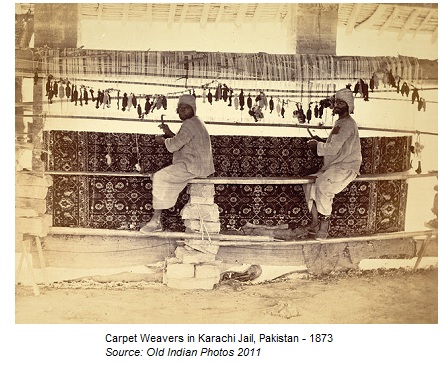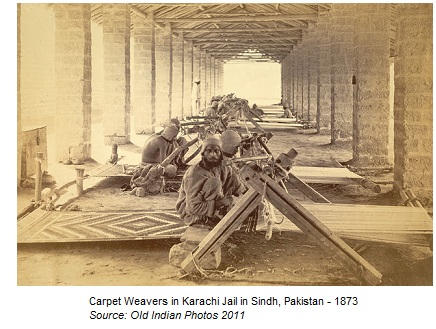A few people have realized that if no one has ever heard of an antique Pakistani rug, it may be because Pakistan didn't exist until after World War II. Until then it was part of India. Some of history's greatest carpets were woven in Lahore, produced for the Mughal court in the 17th and 18th centuries. The art of weaving developed in the region comprising Pakistan at a time when few other civilizations employed it. Excavations at Moenjodaro and Harappa - ancient cities of the Indus Valley civilization - have established that the inhabitants used spindles and spun a wide variety of weaving materials. Some historians consider that the Indus Valley civilization first developed the use of woven textiles.
Carpet weaving may have been introduced into the area of present-day Pakistan as far back as the 11th century with the coming of the first Muslim conquerors, the Ghaznavids and the Ghauris, from the West. It can with more certainty be traced to the beginning of the Mughal Dynasty in the early 16th century, when the last successor of Timur, Babar, extended his rule from Kabul to India to found the Mughal Empire. Under the patronage of the Mughals, Indian craftsmen adopted Persian techniques and designs. Carpets woven in the Punjab at that time (often called Lahore carpets today) made use of motifs and decorative styles found in Mughal architecture.


During the Mughal period, the carpets made on the Indian subcontinent became so famous that demand for them spread abroad. These carpets had distinctive designs and boasted a high density of knots. Carpets made for the Mughal emperors, including Jahangir and Shah Jahan, were of the finest quality. Under Shah Jahan's reign, Mughal carpet weaving took on a new aesthetic and entered its classical phase.


At present, hand-knotted carpets are among Pakistan's leading export products and their manufacture is the second largest cottage and small industry. The number of weavers is estimated around 200,000-250,000. According to the Pakistan Carpet Manufacturers and Exporters Association (PCMEA, 2003) there are 150,000-200,000 looms in the country. Pakistani craftsmen have the capacity to produce any type of carpet using all the popular motifs of gulls, medallions, paisleys, traceries, and geometric designs in various combinations.

Sources and inspiration: Bérinstain, Valérie, et al. L'art du tapis dans le monde (The art of carpets in the world),. Paris: Mengès, 1996. Print.; Jerrehian Jr., Aram K.A. Oriental Rug Primer. Philadelphia: Running Press, 1980. Print.; Herbert, Janice Summers. Oriental Rugs, New York: Macmillan, 1982. Print.; Hackmack, Adolf. Chinese Carpets and Rugs, Rutland and Tokyo: Tuttle, 1980. Print. ; De Moubray, Amicia, and David Black. Carpets for the home, London: Laurence King Publishing, 1999. Print.; Jacobsen, Charles. Oriental Rugs A Complete Guide, Rutland and Tokyo: Tuttle, 1962. Print.; Bashir, S. (n.d.). Personal interview.; Web site sources and dates of consultation vary (to be confirmed). Without prejudice to official usage.


 Tapis d'Orient Bashir | Bashir Persian Rugs
Tapis d'Orient Bashir | Bashir Persian Rugs
 @tapisbashir
@tapisbashir
 @bashircarpets
@bashircarpets
 @bashircarpets
@bashircarpets